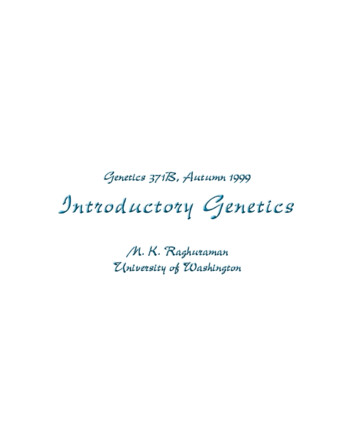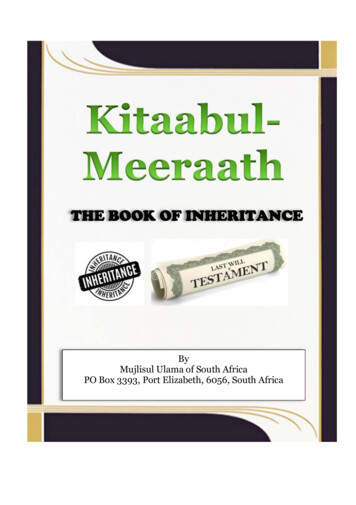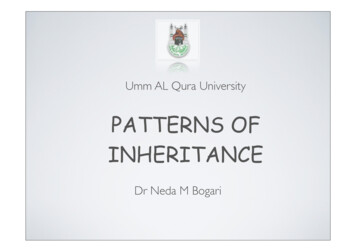
Transcription
Introduction to C InheritanceTopic #3CS202 3- 1
Topic #3 CS202 3- 2Single Inheritance Introduction to Inheritance "Using" versus "Containing" Relationships "Containing" Relationships.through inheritance Inheritance and Derived Classes Creating a Derived Class.the syntax for singleinheritance Creating a Derived Class.constructors &destructors Constructor Initialization Lists What can be Inherited?
CS202 3- 3Multiple and Virtual Inheritance Creating a Derived Class.the syntaxfor multiple inheritance Virtual Inheritance
Object Oriented Programming CS202 3- 4So far we have used classes and objects to representgeneralized abstractions.We learned how to enable these abstractions to be usedin the same contexts as built-in types.We learned what design tradeoffs to make to keep ourabstractions as efficient as possible.But, even though we were using objects, we were notusing object-oriented programming. We were simplyone step closer by understanding the syntax of classesand objects.Our abstractions were limited to stand alone classes.
Object Oriented Programming CS202 3- 5In the object-oriented programming paradigm, webegin to consider using classes in conjunction with oneanother.We should no longer think about classes, or objects, inisolation from one another.Instead of simply creating user defined data types, wecreate a hierarchy of related and interdependent classesand objects, following the natural structure of theproblem.This is because object-oriented programming extendsthe concept of data abstraction to apply acrossabstractions.
Object Oriented Programming CS202 3- 6Object-oriented programming can involve a naturalway of thinking about solutions.We organize information in ways that fit an applicationas it exists in the real world.Unlike procedural abstraction, where we focus on whatactions take place (i.e., verbs), in object-orientedprogramming we focus on the component parts (i.e.,nouns) and the relationships between these parts.This means we must think about creating solutions inan entirely new manner.We first consider nouns, then verbs.
Object Oriented Programming CS202 3- 7Object-oriented solutions are designed based on aninheritance hierarchy which defines the relationshipsbetween classes, where one class shares the structureand/or behavior of one or more classes.To provide this type of design requires that weunderstand how to implement such relationshipsbetween objects. Therefore, our first step inunderstanding object-oriented programming is to learnthe syntax and semantics of inheritance hierarchies.We will also learn how to extend abstractions with newfunctionality even when the code for those abstractionsis not available.
Inheritance Hierarchies CS202 3- 8By defining a class that is based on another class, usinginheritance, one class is a specialization of another.Such a class is said to be a derived class.The class it is derived from is a base class.The derived class inherits the base class' members.The benefit of this type of relationship is that it allowsreuse of existing code from the base class and allows usto focus on the new or specialized behavior in thederived class.An existing program should not be aware that a newderived class has been created if the specializedrelationship is properly defined and encapsulated.
Inheritance Hierarchies CS202 3- 9Every hierarchy has a root (e.g., base class) which haszero or more children.Each child (e.g., derived class) is either a leaf orbranches into children of its own.Each class is inherently related to its parent, as well asto its ancestors.In C , the root of each hierarchy or sub-hierarchy iscalled a base class.If the base class is the parent of the class in question,then it is a direct base class. Otherwise, if it is anancestor, then it is an indirect base class.
Inheritance HierarchiesBase ClassandIndirect Base ClassDerived ClassandBase ClassDerivedClassCS202 3- 10Parent ClassandAncestor ClassChild ClassandParent ClassChildClass
Inheritance Hierarchies Because derived classes inherit the members of the baseclasses, one class' design can be based on existingmembers from another class.Think of this as using building blocks.Instead of starting from scratch with each class that wedesign, we can extend one class from another, reusingan existing class and reducing the need to reinvent.New member functions can be added withoutmodifying the base class itself. And, a derived class canchange the inherited base class client interface byspecifying data members and member functions of thesame name, hiding those inherited from the direct orindirect base classes.CS202 3- 11
Inheritance Hierarchies Base classes are typically used to establish the commonattributes and behavior for an application and to allclasses derived from it. .A derived class may then be used to refine and add tothe base class and represent specialized versions, withnew or altered data/operations.The relationship between a derived class and its baseclass is often called an "is a" relationship. This isbecause a derived class "is a" base class.A derived class is everything the base class is and more,because it has been extended or specialized. A derivedclass object can be used when a base class object isneeded.CS202 3- 12
Single Inheritance When a class is derived from one base class, it is calledsingle inheritance.In this figure, the base class is account.All classes are derived from this class, either directly orindirectly.checking is also a base class of the student class, sincestudent is derived from it.accountThis makes account an indirectbase class of student.checkingsavingsNotice how single inheritancehas a tree-like structure.studentCS202 3- 13
Single Inheritance To specify a derived class, we define the class as welearned but we also add the base class' name as part ofthe derived class' definition.We don't need to alter the base classes to specify whichclasses are derived from them.For public derivation where derived is the name of thederived class and base is the name of the base class:class checking : public account //derivation{public:.};CS202 3- 14
Single Inheritance We specify in the derived class which class is to be itsparent. It is this parent's members that are theninherited by the derived class.Saying class derived : public base establishes a singleinheritance hierarchy.The keyword public specifies that all public members ofthe base class remain public in the derived class.This is called public derivation and is how we specifyan "is a" relationship between two classes.CS202 3- 15
//base classclass account {public:account();void statement();private:char name[32]; //account ownerfloat balance; //account balance};//checking class derived from accountclass checking : public class account {public:checking();float get charges();private:float charges; //charges for current month};//savings class derived from accountclass savings : public account {public:savings();float get interest();private:float interest; //interest for current month};CS202 3- 16
Single Inheritance Saying class checking : public account when definingthe checking class indicates that checking is a derivedclass.The keyword public tells the compiler that all publicmembers of the account class remain public in thechecking class (i.e., public derivation is taking place).The name account tells the compiler that the checkingclass is derived from the account class.The account class is the direct base class for checkingand savings.CS202 3- 17
Single Inheritance Objects of the checking and savings classes contain allof the members of an account object and can be usedwhere ever an account object can be used.savings kingsavingssavings::get interest()interestchecking et charges()chargesCS202 3- 18
Single Inheritance Even though inheritance hierarchies allow derivedclasses to inherit members from their base classes, itdoes not mean that those members will be accessiblewithin a derived class.This is because members within a hierarchy have theirown visibility.As we have seen, public members of a base class arevisible and fully accessible by classes derived fromthem. And, data and member functions in the privatesection are only available to the class in which they aredefined. They are not accessible to any other class (withthe exception of friends).CS202 3- 19
Single Inheritance Derived classes do not have access to a base class'private data and member functions, even though theyare inherited.Even though memory is allocated for such datamembers, they may only be accessed from memberswithin the base class itself (or friends).This is important because giving any other class(besides a friend) access to private information wouldcompromise our ability to ensure data hiding andencapsulation.Such a compromise would decrease the value ofprogramming with objects.CS202 3- 20
Single Inheritance Previously, we recommended that data members bespecified in the private section.By following this guideline when designing hierarchies,all derived classes would explicitly need to use the baseclass' public member functions to access inherited data.This isn't practical when building classes that areintended to work in harmony with one another. And, itreduces our ability to extend the functionality of agiven class in the future.By declaring members as protected, derived classeshave access to base class members while restrictingaccess by client applications.CS202 3- 21
Constructors in Hierarchies A base class constructor is always invoked before aderived class constructor in an inheritance hierarchy.This means that a derived class' constructor can assumethat the base class members have been initialized by thetime it is executed.The body of a derived class constructor is executed lastafter the base class and all indirect base classconstructors within the hierarchy have executed.But, when we have a derived class, we are not explicitlyusing the base class' constructor. Instead, the base class’constructor is implicitly invoked by the derived classconstructor that initializes the base class members.CS202 3- 22
Constructors in Hierarchies When the base class has a default constructor, it isautomatically invoked when an object of the derivedclass is defined. This happens whether or not thederived class constructor is a default constructor orrequires arguments.Supplying a default constructor in our base classesallows for the most straightforward class design. And,supplying a default constructor in a derived classmakes it easier to use if classes are subsequentlyderived from it.CS202 3- 23
Constructors - Page 1 of 2#include iostream.h class account {public:account();private:char name[32];float balance;};class checking : public account {public:checking();private:float charges;};class savings : public account {public:savings();private:float interest;};CS202 3- 24
Constructors - Page 2 of 2#include "account.h"account::account() : balance(0) {strncpy(name, "none", 32);name[31] '\0';cout "account constructor called" endl;}checking::checking() : charges(5) {cout "checking constructor called" endl;}savings::savings() : interest(0) {cout "savings constructor called" endl;}After the client saying:checking c;savings s;account constructor calledchecking constructor calledaccount constructor calledsavings constructor calledCS202 3- 25
Constructors in Hierarchies If a base class constructor expects an argument list, thederived class must explicitly specify the base classconstructor's arguments.If it doesn't, then the base class is expected to have adefault constructor, which is implicitly called.We explicitly specify the base class constructor'sarguments by listing the base class constructor in thederived class' initialization list along with the actualarguments expected by the base class constructor.Client program:derived obj(10,20);derived::derived(int i, int j) {.CS202 3- 26
Constructors in Hierarchies The arguments to the base class constructor can onlyconsist of values supplied as arguments to the derivedclass constructor, constants, literals, global variables, orexpressions made up from such values.We cannot use derived class data members asarguments to a base class constructor nor can weinvoke a member function of the derived class and useits return value as one of the actual arguments becausethe derived class has not yet beeninitialized.CS202 3- 27
Constructors - Page 1 of 2class account {public:account(const char* name "none", float amount 0);void statement();private:char name[32];float balance;};class checking : public account {public:checking(const char* "none", float 0, float 5);float get charges();private:float charges;};class savings : public account {public:savings(const char* "none", float 0);float get interest();private:float interest;};CS202 3- 28
Constructors - Page 2 of 2account::account(const char* n, float b) :balance(b) {strncpy(name, n, 32); name[31] '\0';}void account::statement() {cout "Account Statement" endl;cout " name " name endl;cout " balance " balance endl;}checking::checking(const char* n, float b, float c) :account(n, b), charges(c) {}float checking::get charges() {return (charges);}savings::savings(const char* n, float b) :account(n, b), interest(0) {}float savings::get interest() {return (interest);}What values do the data members have when the client says:checking c("Sue Smith", 1000.0);savings s("Jim Jones", 500.0);CS202 3- 29
Constructors in Hierarchies The initialization list causes the base class constructorto be invoked with the correct arguments!The order of the arguments for the base class is veryimportant. They must be listed in the same order as thebase class constructor expects.If we had not in
Inheritance Hierarchies By defining a class that is based on another class, using inheritance, one class is a specialization of another. Such a class is said to be a derived class. The class it is derived from is a base class. The derived class inherits the base class' members. The benefit of










